Biostar TPower i55 – Super Middle Weight Contender
by Rajinder Gill on November 25, 2009 12:00 PM EST- Posted in
- Motherboards
Performance Summary
Performance is indistinguishable from other P55 motherboards - these products all perform about the same at stock or even overclocked speeds:
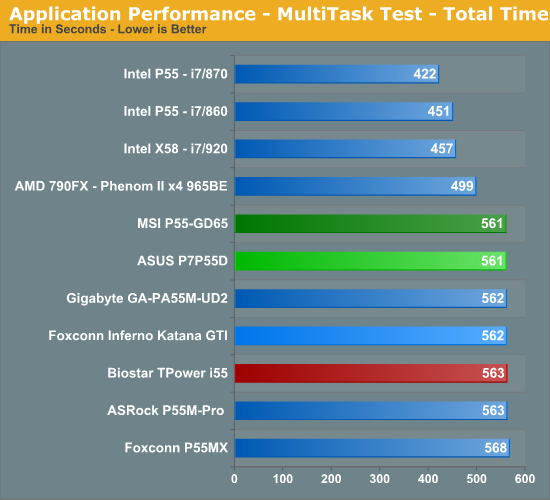
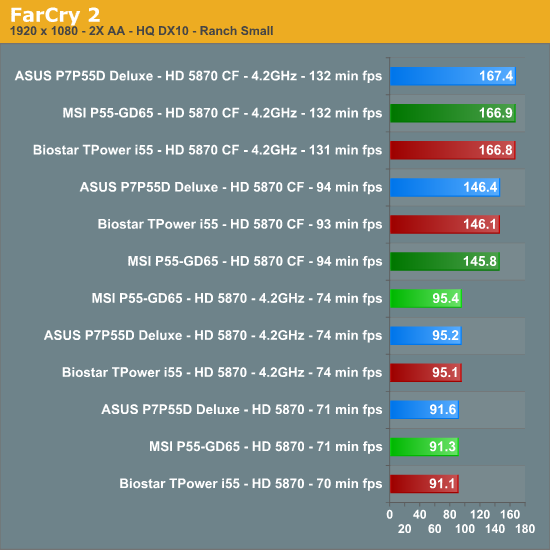
Biostar provides a great PWM/FET design for stability and overclocking, which also results in very good power consumption results..
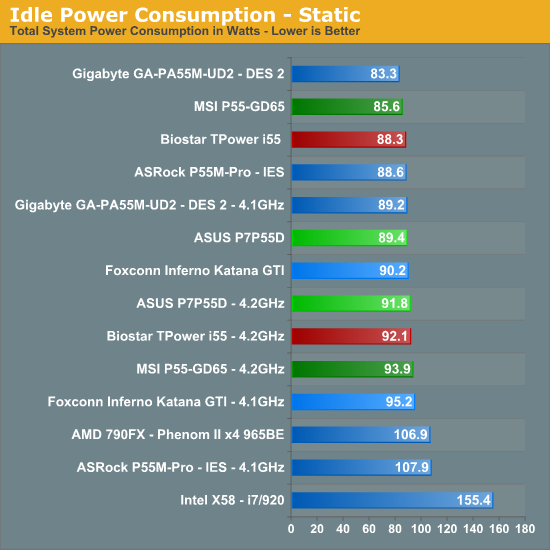
Of course, one of the key questions that invariably comes up in regards to a board’s performance capability is just how well it overclocks.
Core i5/750 8GB Results -
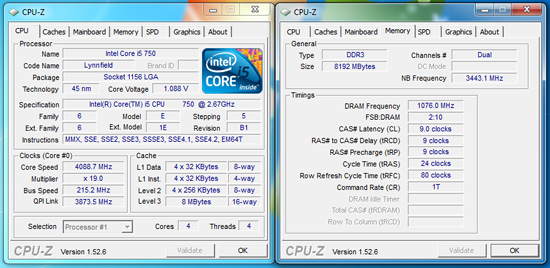
Gary had excellent results with his retail processors on this board in both 4GB and 8GB configurations. His primary problem encountered during overclocking with all three processors was the inability of the board to hold tight sub-timings with 8GB of memory above DDR3-2000. While the board would easily clock 8GB up to DDR3-2200 with 1.66V VDimm and VTT around 1.38V, we usually had to run CAS9 timings and loosen tFAW and B2B slightly to retain memory stability.
The Everest results show read/copy rates being up to 20% lower than a 4GB configuration at like timings, indicating Biostar still has some MSR/MRC tuning to complete in the BIOS. However, actual performance in games and applications never varied by more than 1%, so in some ways it just does not matter that much unless you are comparing synthetic benchmarks.
With all three processors, we never had to increase CPU PLL or the PCH voltages. VDimm was kept at 1.66V, VTT at 1.34V~1.38V, and VCore load voltages differed slightly between processors. Our i5-750 required 1.360V for 4.1GHz, i7-860 needed 1.425V for 4.3GHz, and the i7-870 hit 4.4GHz with 1.4V. Interestingly enough, our i5-750 would top out right around 4.1GHz regardless of voltages or cooling.
Core i7/860 and i7/870 8GB Results-
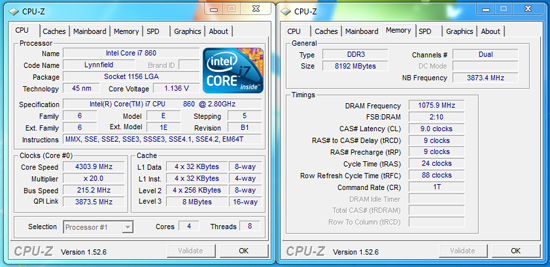
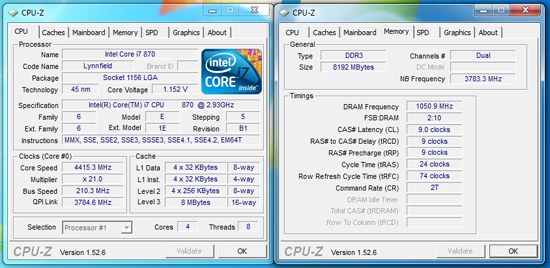
We had absolutely no problems clocking our i7/860 to 4.3GHz and the i7/870 to 4.4GHz with 8GB of memory.
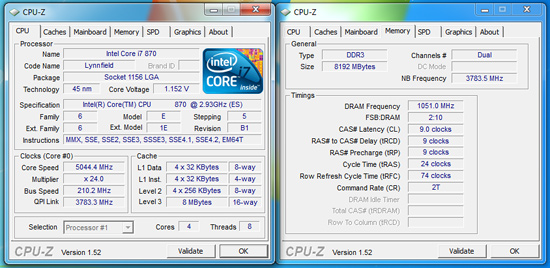
Just for fun, we pulled out our “cherry” i7-870 ES sample just to see what we could do on air in a suicide run for a screenshot. For the first time in our P55 testing, we were able to POST, enter Win7 x64, and take a few screenshots above 5GHz. The system was even stable enough to run SuperPi 1M, but not much else, in fact, just starting the Crysis or PCMark Vantage benchmarks would lock the system. However, it just goes to show that this board is capable of high overclocks for the vast majority of users on air or water cooling. Our maximum stable Bclk rate on air was 220.
If you want more details on the Biostar TPower i55, please continue on.










39 Comments
View All Comments
treesloth - Monday, December 7, 2009 - link
I first used the internet when the main protocol was IP over smoke signals, so keep your fancy "flexibility" off my lawn!Seriously, though, good points. I also have to compliment Anandtech on basing their article layouts on visitor convenience, as opposed to the many sites that seem to try to herd as many visitors as possible into as many page views (and ad impressions) as possible.
Rajinder Gill - Thursday, November 26, 2009 - link
Yes, the summary/conclusion is on the first page. For the exact reason that Bull Dog mentions. We've had a lot of requests from people that want 'bare all' on the first page, so here it is. Saves you having to trundle through every page picking up tidbits here and there of what the board can or cannot do. We know it won't appease everybody, but then appeasing everybody is impossible anyway..lolregards
Raja
poohbear - Thursday, November 26, 2009 - link
I think it doesnt make sense. who says u hafta "trundle" through every page to get to the conclusion?? u just click the drop down menu & go to the conclusion. A site for computer enthusiasts & the readers can't even figure out how to use a drop down menu????Devo2007 - Thursday, November 26, 2009 - link
I agree - the new layout is confusing.What I'd suggest is a small summary of the article (either Pros/Cons, or small highlights of the product being reviewed. That way, people can get a quick overview of the product, and delve into the article more if they wish.
Putting the full-fledged conclusion on the main page just doesn't seem to fit right.
Rajinder Gill - Thursday, November 26, 2009 - link
I'll try and find a happy medium that does not confuse people too much..loltreesloth - Monday, December 7, 2009 - link
Put the conclusion right in the middle-- page 10 of a 20-page review. Oh, and since programming languages can't seem to settle whether indexing should start at 0 or 1, we'll compromise and start at .5.Seriously, though, I think people will get a little confused exactly once, figure it out, and never have another problem. I like the new way.
sonci - Thursday, November 26, 2009 - link
Its called abstract,its used on medical articles..
Rajinder Gill - Thursday, November 26, 2009 - link
Whichever way you look at it; you click on the review, read the first page for everything relevant and then if it interets you to lo at the figures, read on. Can't get much simpler than that.later
Raja
Bull Dog - Wednesday, November 25, 2009 - link
First/second page conclusion.Kinda wierd but I like it over the standard "go through 11 gazillion pages of nearly meaningless numbers."